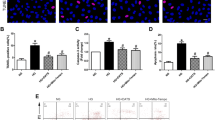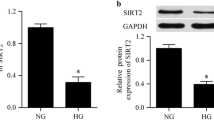Abstract
Objective
To investigate whether ginsenoside Rb1 (Rb1) can protect human umbilical vein endothelial cells (HUVECs) against high glucose-induced apoptosis and examine the underlying mechanism.
Methods
HUVECs were divided into 5 groups: control group (5.5 mmol/L glucose), high glucose (HG, 40 mmol/L) treatment group, Rb1 (50 µ mol/L) treatment group, Rb1 plus HG treatment group, and Rb1 and 3-(1H-1,2,3-triazol-4-yl) pyridine (3-TYP, 16 µ mol/L) plus HG treatment group. Cell viability was evaluated by cell counting kit-8 assay. Mitochondrial and intracellular reactive oxygen species were detected by MitoSox Red mitochondrial superoxide indicator and dichloro-dihydro-fluorescein diacetate assay, respectively. Annexin V/propidium iodide staining and fluorescent dye staining were used to measure the apoptosis and the mitochondrial membrane potential of HUVECs, respectively. The protein expressions of apoptosis-related proteins [Bcl-2, Bax, cleaved caspase-3 and cytochrome c (Cyt-c)], mitochondrial biogenesis-related proteins [proliferator-activated receptor gamma coactivator 1-alpha, nuclear respiratory factor-1 and mitochondrial transcription factor A)], acetylation levels of forkhead box O3a and SOD2, and sirtuin-3 (SIRT3) signalling pathway were measured by immunoblotting and immunoprecipitation.
Results
Rb1 ameliorated survival in cells in which apoptosis was induced by high glucose (P<0.05 or P<0.01). Upon the addition of Rb1, mitochondrial and intracellular reactive oxygen species generation and malondialdehyde levels were decreased (P<0.01), while the activities of antioxidant enzymes were increased (P<0.05 or P<0.01). Rb1 preserved the mitochondrial membrane potential and reduced the release of Cyt-c from the mitochondria into the cytosol (P<0.01). In addition, Rb1 upregulated mitochondrial biogenesis-associated proteins (P<0.01). Notably, the cytoprotective effects of Rb1 were correlated with SIRT3 signalling pathway activation (P<0.01). The effect of Rb1 against high glucose-induced mitochondria-related apoptosis was restrained by 3-TYP (P<0.05 or P<0.01).
Conclusion
Rb1 could protect HUVECs from high glucose-induced apoptosis by promoting mitochondrial function and suppressing oxidative stress through the SIRT3 signalling pathway.
Similar content being viewed by others
References
Dokken B. Mechanisms of cardiovascular injury in type 2 diabetes and potential effects of dipeptidyl peptidase-4 inhibition. J Cardiovasc Nurs 2016;31:274–283.
Romacho T, Vallejo S, Villalobos LA, Wronkowitz N, Indrakusuma I, Sell H, et al. Soluble dipeptidyl peptidase-4 induces microvascular endothelial dysfunction through proteinase-activated receptor-2 and thromboxane A2 release. J Hypertens 2016;34:869–876.
Sena CM, Pereira AM, Seica R. Endothelial dysfunction—a major mediator of diabetic vascular disease. Biochim Biophys Acta 2013;1832:2216–2231.
Chen WJ, Wang JL, Luo Y, Wang T, Li XC, Li AY, et al. Ginsenoside Rb1 and compound K improve insulin signaling and inhibit ER stress-associated NLRP3 inflammasome activation in adipose tissue. J Ginseng Res 2016;40:351–358.
Guo S, Chen YF, Pang CL, Wang XZ, Qi JL, Mo L, et al. Ginsenoside Rb1, a novel activator of the TMEM16A chloride channel, augments the contraction of guinea pig ileum. Pflugers Arch 2017;469:681–692.
Li YH, Li YY, Fan GW, Yu JH, Duan ZZ, Wang LY, et al. Cardioprotection of ginsenoside Rb1 against ischemia/reperfusion injury is associated with mitochondrial permeability transition pore opening inhibition. Chin J Integr Med 2016;22:1–10.
Zhou P, Lu S, Luo Y, Wang S, Yang K, Zhai YD, et al. Attenuation of TNF-alpha-induced inflammatory injury in endothelial cells by ginsenoside Rb1 via inhibiting NF-kappaB, JNK and p38 signaling pathways. Front Pharmacol 2017;8:464.
Song ZM, Liu Y, Hao BS, Yu SJ, Zhang H, Liu DH, et al. Ginsenoside Rb1 prevents H2O2-induced HUVEC senescence by stimulating sirtuin-1 pathway. PLoS One 2014;9:e112699.
Susztak K, Raff AC, Schiffer M, Bottinger EP. Glucose-induced reactive oxygen species cause apoptosis of podocytes and podocyte depletion at the onset of diabetic nephropathy. Diabetes 2006;55:225–233.
Widder JD, Fraccarollo D, Galuppo P, Hansen JM, Jones DP, Ertl G, et al. Attenuation of angiotensin II-induced vascular dysfunction and hypertension by overexpression of thioredoxin 2. Hypertension 2009;54:338–344.
Twig G, Hyde B, Shirihai OS. Mitochondrial fusion, fission and autophagy as a quality control axis: the bioenergetic view. Biochim Biophys Acta 2008;1777:1092–1097.
Chun F, Zhang BB, Lin H, Gao CF, Min W. d-Fagomine attenuates high glucose-induced endothelial cell oxidative damage by upregulating the expression of PGC-1alpha. J Agric Food Chem 2018;66:2758–2764.
Xu S, Gao Y, Zhang Q, Wei S, Chen Z, Dai X, et al. SIRT1/3 activation by resveratrol attenuates acute kidney injury in a septic rat model. Oxid Med Cell Longev 2016:7296092.
Rardin MJ, Newman JC, Held JM, Cusack MP, Sorensen DJ, Li B, et al. Label-free quantitative proteomics of the lysine acetylome in mitochondria identifies substrates of SIRT3 in metabolic pathways. Proc Natl Acad Sci USA 2013;110:6601–6606.
van der Horst A, Burgering BM. Stressing the role of FoxO proteins in lifespan and disease. Nature Rev Mol Cell Biol 2007;8:440–450.
Yang K, Zhang HJ, Luo Y, Zhang JY, Wang M, Liao P, et al. Gypenoside XVII prevents atherosclerosis by attenuating endothelial apoptosis and oxidative stress: insight into the ERalpha-mediated PI3K/Akt pathway. Int J Mol Sci 2017;18:77.
Tsukada S, Masuda H, Jung SY, Yun J, Kang S, Kim DY, et al. Impaired development and dysfunction of endothelial progenitor cells in type 2 diabetic mice. Diabetes Metab 2017;43:154–162.
Sun S, Liu L, Tian XJ, Guo YH, Cao YK, Mei YQ, et al. Icariin attenuates high glucose-induced apoptosis, oxidative stress, and inflammation in human umbilical venous endothelial cells. Planta Med 2019;85:473–482.
Zhou P, Xie WJ, He SB, Sun YF, Meng XB, Sun GB, et al. Ginsenoside Rb1 as an anti-diabetic agent and its underlying mechanism analysis. Cells 2019;8:204.
Zhao HJ, Ma T, Fan BY, Yang L, Han C, Luo JG, et al. Protective effect of trans-delta-viniferin against high glucose-induced oxidative stress in human umbilical vein endothelial cells through the SIRT1 pathway. Free Radic Res 2016;50:68–83.
Giralt A, Villarroya F. SIRT3, a pivotal actor in mitochondrial functions: metabolism, cell death and aging. Biochem J 2012;444:1–10.
Dai SH, Chen T, Wang YH, Zhu J, Luo P, Rao W, et al. SIRT3 attenuates hydrogen peroxide-induced oxidative stress through the preservation of mitochondrial function in HT22 cells. Int J Mol Med 2014;34:1159–1168.
Rangarajan P, Karthikeyan A, Lu J, Ling EA, Dheen ST. Sirtuin 3 regulates FOXO3a-mediated antioxidant pathway in microglia. Neuroscience 2015;311:398–414.
Tseng AH, Shieh SS, Wang DL. SIRT3 deacetylates FOXO3 to protect mitochondria against oxidative damage. Free Radic Biol Med 2013;63:222–234.
Dikalova AE, Itani HA, Nazarewicz RR, McMaster WG, Flynn CR, Uzhachenko R, et al. SIRT3 impairment and SOD2 hyperacetylation in vascular oxidative stress and hypertension. Circ Res 2017;121:564–574.
Xie XX, Wang LL, Zhao BG, Chen YY, Li JQ. SIRT3 mediates decrease of oxidative damage and prevention of ageing in porcine fetal fibroblasts. Life Sci 2017;177:41–48.
Jacobs KM, Pennington JD, Bisht KS, Aykin-Burns N, Kim HS, Mishra M, et al. SIRT3 interacts with the daf-16 homolog FOXO3a in the mitochondria, as well as increases FOXO3a dependent gene expression. Int J Biol Sci 2008;4:291–299.
Wu Y, Xia ZY, Dou J, Zhang L, Xu JJ, Zhao B, et al. Protective effect of ginsenoside Rb1 against myocardial ischemia/reperfusion injury in streptozotocin-induced diabetic rats. Mol Biol Rep 2011;38:4327–4335.
Shen NN, Li XG, Zhou T, Bilal MU, Du N, Hu YY, et al. Shensong Yangxin Capsule prevents diabetic myocardial fibrosis by inhibiting TGF-β 1/Smad signaling. J Ethnopharmacol 2014;157:161–170.
Author information
Authors and Affiliations
Contributions
Ke SY, Yu SJ, Wu L and Qian XX contributed to the conception and design of this work. Liu DH, Shi GY, Wang M and Song ZM contributed to data analyses. Ke SY, Zhou B, Zhu JM and Wu CD wrote the manuscript. All authors read and approved the final manuscript.
Corresponding author
Additional information
Conflict of Interest
The authors declare that they have no conflict of interest.
Supported by the National Natural Science Foundation of China (No. 81370447), Science and Technology Planning Project of Guangdong Province, China (No. 2016A050502014), and the Ph.D. Start-up Fund of Natural Science Foundation of Guangdong Province, China (No. 2015A030310048, and 2016A030310203)
Rights and permissions
About this article
Cite this article
Ke, Sy., Yu, Sj., Liu, Dh. et al. Ginsenoside Rb1 Protects Human Umbilical Vein Endothelial Cells against High Glucose-Induced Mitochondria-Related Apoptosis through Activating SIRT3 Signalling Pathway. Chin. J. Integr. Med. 27, 336–344 (2021). https://doi.org/10.1007/s11655-020-3478-8
Accepted:
Published:
Issue Date:
DOI: https://doi.org/10.1007/s11655-020-3478-8




